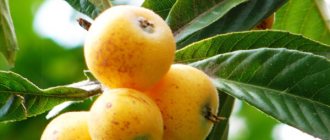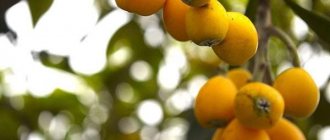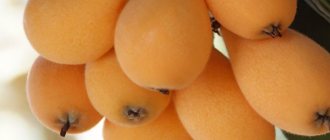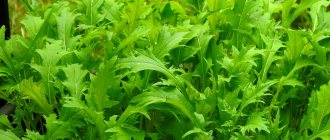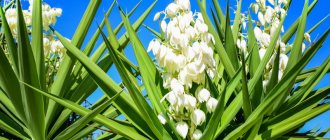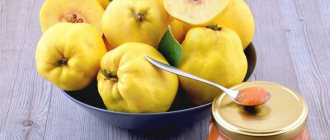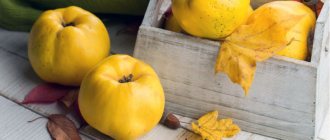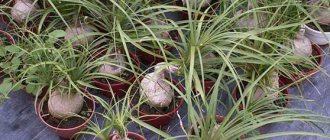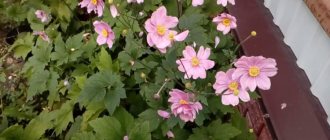Description of medlar
Under natural conditions, the height of a wild deciduous tree reaches 8 m. The trunk is curved, the bark has shallow cracks.
The leaves of the medlar are large, up to 10 cm long, 6 cm wide. Dense, leathery, slightly wrinkled, slightly concave towards the center. Smooth on top, covered with velvety down below.
Flowering is abundant. Small flowers are collected in inflorescences, they have a white or cream color, a light almond aroma, and are honey-bearing. The fruits are yellow-orange or red-brown, from 3 to 8 cm in diameter, and are round, flattened, oval and pear-shaped. The pulp is tart, dense, and after freezing and fermentation it becomes sweet and soft. The fruits have from one to three seeds, sometimes more, up to eight.
Where is the best place to plant German medlar?
Is it possible to grow medlar at home in Russia, and how to do it, you will learn from the article.
Southeast Asia is considered the birthplace of the tropical fruit. The crop is grown in the Caucasus and Turkey. Warm countries where the temperature does not fall below 0 Celsius are suitable for growing the plant.
If you grow medlar in central Russia, in the Moscow region or in Ukraine, you will get an ornamental shrub. But if you follow agrotechnical recommendations, you will get a beautiful tree with tasty fruits.
Medlar berries contain a large amount of useful vitamins and minerals. The culture has a low calorie content.
The fruit contains the following beneficial substances:
- vitamins A, B, C;
- folic and ascorbic acid;
- potassium;
- iodine;
- manganese;
- selenium;
- calcium;
- magnesium.
Medlar berries contain a large amount of useful vitamins and minerals.
Dietitians usually prescribe the plant for overweight. If consumed in sufficient quantities, the fruit will bring great benefits to the body.
The benefit of the fruit is that it is rich in vitamin A, which is considered essential for human eyes. Eating medlar will improve the muscles of the eyes and help restore lost shine.
In cooking, jams, compotes, jams, and liqueur liqueurs are prepared from medlar.
Who is not recommended to eat tropical fruit:
- If ulcers of the stomach and duodenum are detected, exclude the plant from the diet.
- If the pancreas is inflamed, this is a contraindication for eating medlar.
- With increased acidity and severe gastritis, it is not recommended to eat fruit.
Wine and juices will only bring harm to such people, but jams and preserves will be beneficial.
A tropical plant can cause an allergic reaction, so for children, limit the use of the crop or give it after consulting a specialist.
Medlar - a Japanese relative of the Russian hawthorn
Loquat, like other fruits, can bring many benefits to the human body:
- A decoction of the leaves makes an excellent hemostatic agent.
- The fruit can be used to treat urolithiasis to remove stones.
- The healing culture acts as the first assistant for gastrointestinal diseases. After eating pilaf, digestion improves. To get rid of bloody diarrhea, you need to prepare a decoction of unripe fruit.
- An alcohol tincture made from the plant can help cure asthma and bronchitis. Thanks to the use of this remedy, breathing becomes easier and the cough gradually disappears. The tincture can treat pain in the heart.
- If you gargle with an infusion of the leaves of the variety, the cold will not occur or will disappear for a long time.
If a person has kidney dysfunction, it is recommended to consume medlar to increase their filtration. This fruit contains molecular water, so the human body can easily get rid of toxins after consuming the plant.
Ordinary plant seeds serve as seedlings. Before growing the seeds, it is recommended to keep them in the cold for no more than 3-4 months.
Natural conditions allow the formation of sprouts in the 2-3rd year of life, when the shell is destroyed.
To speed up the procedure, a sulfuric acid solution is used, the seeds are placed in it and left for 5 hours, and then washed.
Mulch the soil using sawdust, peat or plastic film. A good option for planting seeds indoors: after the formation of the first shoots of 25-30 centimeters, the plant must be grown in advance and placed in a designated place.
Loquat seeds can serve as excellent material for seedlings
It is necessary to plant seedlings in prepared soil containing the following components:
- deciduous soil;
- sand;
- humus.
Before planting, it is recommended to dig a hole no larger than the size of the soil ball, designed for the root system. The seedlings are placed in the holes carefully, without damaging the roots, and then the soil mixture must be covered on top.
Before planting a medlar seedling, cut the leaves in half, dig a hole and place the plant there
If the leaves are cut in half, you can reduce moisture evaporation. To prevent rotting, as well as to prevent the penetration of pathogens, it is recommended to sprinkle wood ash at the cut sites.
Cultivation care:
- in summer, the plant needs abundant watering, preventing the soil from drying out;
- leaf cover does not require constant spraying;
- direct sunlight is not a hindrance for the variety; lighting should be sufficient;
- after harvesting, it is necessary to prune the crown;
- a soil mixture taken in equal proportions is excellent;
- from April to September it is necessary to fertilize;
- Young trees need to be replanted every spring; for adult plants, replanting is done once every 3-4 years.
The roots of the plant can get bacterial burn if the soil contains a large amount of nitrogen. Frequent watering will also damage the root system.
Artificial pollination is necessary for the fruit during the flowering period. It is necessary to engage in the formation of the crown, and cut off dry and damaged branches in a timely manner.
Most gardeners know that crops are susceptible to diseases and pest attacks. The plant is eaten by aphids and thyroid gland.
The shrub needs to be treated with insecticides twice a season. In this way, the variety can be protected from spoilage.
Treatment is carried out with “Fitoverm” - no more than 2 milligrams per 1 liter of water, “Insegar” - use 5 grams of the drug per 10 liters of water, “Lepidocide” - dissolve 30 grams of the substance in a 10 liter volume of water.
We suggest you read: Do-it-yourself chainsaw repair
After coloring the fruits, you should not immediately begin harvesting. During this period, the fruit pulp has excessive astringency.
When the fruits begin to turn brown, the tart taste disappears, and the plant becomes sweet and suitable for collection and further consumption.
Ripe fruits must be collected carefully without damaging them. Whole fruits will stand for a long time without spoiling.
To store a tropical crop, it is necessary to provide a cool place without access to light, but it is also possible to store the plant at room temperature. The fruits should not touch each other while lying down.
You need to collect medlar when the fruits begin to turn brown - their astringency disappears, they become sweet
To grow varietal medlar, you need to select seedlings with the best qualities of the mother plant.
Tanaka are large-sized fruits, yellow-orange in color. Usually reach a weight of 50-80 grams. The aromatic pink pulp is characterized by juiciness and a delicate sweet and sour taste.
Champagne is a large-sized crop with a slight fluffiness, the color of the fruit is bright yellow. The pulp has a light cream color, the taste of the fruit is delicate and pleasant.
Premier - the fruits of this variety are distinguished by an orange-yellow hue. This variety has juicy creamy pulp and a delicate sour taste.
Sales - the usual weight of a ripe fruit is 80 grams. The taste of the crop resembles apricot.
In addition to high taste, the fruits are preserved for a long time and are not damaged during transportation. Simple agrotechnical recommendations allow a novice gardener to grow them at home.
Without leaving home after 4-5 years, you can harvest a good harvest of exotic fruits.
Morozko is considered a suitable crop for growing not only indoors or in a greenhouse, but also for a winter garden. The low degree of fragility of wood allows you to install the plant in any shape.
Large fruits, rich in aroma and lacking astringency, are characterized by the presence of a large amount of vitamins. The berries are red-brown in color.
Popular varieties of medlar: Morozko, Tanaka, Sales, Premier, Champagne
Among the fruit trees in the garden, the medlar will take pride of place and will delight its owner with delicious fruits for many years.
This wonderful tropical fruit is suitable for fresh consumption, as it is rich in beneficial properties.
Before use, the peel is removed from the plant. It is not healthy, does not have a pleasant taste, and it is advisable not to consume it.
Types and varieties of garden medlar
Among the three types of chishkova tree, two are most widespread: German medlar (Caucasian) and Japanese (loqua). They are successfully cultivated in the middle zone; there are up to 30 varieties. For the middle climatic zone, a low-growing plant with a crown with a diameter of up to 3 m was bred. It grows well in Russia.
Caucasian medlar blooms in the spring, in May-June, the growing season lasts until the onset of cold weather. Annual shoots often freeze slightly. In the middle zone, seedless and seed varieties are cultivated.
| Varieties of German medlar | Features of the fruit | Presence of seeds |
| Apirena | Yellow with orange splashes, round, medium. | No |
| Goytkhskaya | Yellow-brown, small. | There is |
| Huge Evreinova | Pear-shaped, large. | No |
| Monstrous d Evreinov | Yellow-orange, pear-shaped, large. | There is |
| Sweet Dracheva | Yellow with brown spray, plum-shaped. | There is |
| Sochi | Bright yellow, small. | No |
| Khvamli | Round, brownish, medium size. | There is |
Japanese medlar blooms in autumn, the fruits remain on the branches in winter, and ripen in early summer - in June. The ovaries do not fall off in winter only in southern and temperate latitudes. In other areas, such medlar is grown in apartments, greenhouses, and winter gardens.
| Varieties of Japanese medlar | Features of the fruit |
| Commune | Light yellow, round, large. |
| Morozko | Red-brown, medium. |
| Premier | Yellow-orange, large. |
| Silas | Bright yellow, oval, large. |
| Tanaka | Orange, pear-shaped, medium. |
| Champagne | Yellow, pear-shaped, large. |
Photo gallery
To begin with, we note that medlar is divided into two types: Japanese and German (aka Caucasian). Japanese is an evergreen shrub or small tree. The fruits of this plant in appearance resemble ranetki, which are so familiar to each of us.
We suggest you read: How to clean blood vessels with medications for hypertension
Japanese medlar can only grow in southern countries. It begins to bloom in mid-autumn and bears fruit in the spring. Unfortunately, it is not suitable for the climate of our region. But the German one is an excellent option for Russia, namely for its southern regions.
In addition to the fact that medlar is incredibly tasty, it is also very healthy, which is why it is of particular interest. The fruits of this plant contain a fairly large amount of vitamin C, which strengthens our immunity and improves the general condition of the body.
Medlar has a positive effect on human blood vessels, liver and muscle function. It is recommended to be used to prevent blood clots, strokes and heart attacks; it can quickly bring your blood pressure and nervous system back to normal.
In order to grow seedlings, we need the seeds of this plant. In order for them to germinate and turn into sprouts, they must first be kept at low temperatures (for example, in the refrigerator) for 4 months. This will help speed up the growing process.
Before planting the seeds in the soil, they should be placed in warm water and left there for 24 hours. After planting the seeds in the ground, it is worth mulching the soil using peat or sawdust. You can cover the hole using plastic wrap.
If the German medlar attracted you so much that you decided to grow the plant in the Moscow region, then first of all, select and correct the composition of the soil and its condition correctly. The soil should be loose and sufficiently drained.
Having dug a hole in which we will plant the medlar, it is necessary to prepare a mixture of organic fertilizers. Its composition should include: turf, sand, deciduous soil and humus in equal proportions. Having lowered the seedling into the hole, you need to sprinkle the roots with the prepared mixture.
Basic care for this plant consists of timely watering and loosening the soil. It is worth remembering that medlar needs regular fertilization of the land. This procedure must be carried out about three times a season. Fertilizers must be organic and mineral.
You should monitor the condition of the plant branches. Dry, damaged ones need to be removed. Do not forget to form the tree crown correctly. Medlar is one of the plants that are most susceptible to numerous diseases.
To prevent them, it is recommended to pollinate the tree with special insecticide solutions. These include Fitoverm, Insegar and Lepidocid. They will help get rid of both many diseases and pests.
We recommend that you read
Loquat is a subtropical plant belonging to the Rosaceae family. The two most common types are:
- Medlar Caucasian (German).
- Japanese medlar.
In this article we will talk about medlar, the photo of which is presented below.
Caucasian and Japanese medlar differ significantly from each other. It reaches a height of six meters, but if grown at home, it can only grow up to two meters. It has sweet and tasty fruits that contain a large amount of vitamins and nutrients.
The Caucasian medlar is a tree with a well-developed trunk, 20 centimeters in diameter, which sheds its leaves in winter. May be in the form of a bush.
Its shoots contain thorns. The leaves have a beautiful dark green color, quite large, which bloom at the end of April. Flowers with five petals are formed at the tips of the shoots. The flowers are initially white, later turning a lovely shade of pink with a wonderful aroma.
It begins to bloom at the end of May. The fruits of this plant ripen in autumn, are red-brown in color and become edible after frost. The pulp tastes sweet and sour. The shape of the fruit is usually spherical or oval. One fruit has several seeds. They remain on the branches all winter.
Location of medlar in the garden
Medlar is a light-loving plant; to grow it in the garden, choose the sunniest place. Taking into account the size of the crown, maintain a distance between plantings of up to 1.5 m. For full fruiting, two or three trees are planted nearby. It tolerates proximity to currants well.
Moderate humidity is needed; medlar does not like close proximity to water and is prone to root rot. The distance to the aquifer must be at least 1 m. When choosing soil, preference is given to neutral and slightly acidic soils; podzol soils will not yield much.
Proper planting and care in open ground is the key to good yield.
Planting a seedling
To grow seedlings, choose seeds from fresh ripened fruits; during storage, germination is significantly reduced. Only mature seedlings up to 30 cm high are transferred to the ground.
Landing algorithm:
- a month before planting, prepare a planting hole up to 50 cm deep;
- the extracted soil is well loosened, freed from weeds, then returned to the planting hole;
- before planting, dig small holes, 1/3 larger in volume than the size of the pot in which the seedling grew;
- prepare a soil mixture: humus, sand, peat, compost substrate are taken in equal proportions or purchase packaged soil for tomatoes;
- water generously, press down so that voids do not form, and install a support;
- the next day, the tree trunk circle is loosened and mulched with humus.
Medlar... it's so different
It turns out that there are two varieties of medlar, which sometimes even botanists get confused about. One -
, which is an evergreen tree (less often a shrub).
Loquat japonica (loquat)
It belongs to the Rosaceae family, the Apple subfamily, and its fruits are shaped like ranetki. And the taste is something between pear and cherry, with a small amount of sourness. The Japanese capricious plant lives only in the south, blooms in the fall, and produces fruits in the spring, so it is not at all suitable for growing in open ground in most Russian regions. It's a pity…
But there is a way out! This is the German medlar (it is also called Caucasian), which is more tolerant of the Russian climate and takes root well in the gardens of southern Russia.
We suggest you read: What grows best in a greenhouse
Medlar
The German medlar is a deciduous fruit tree (or shrub), also from the Rosaceae family, but has nothing to do with the Appleaceae subfamily. This is such a confusing pedigree.
Features of caring for medlar in open ground
Medlar does not tolerate drought and needs regular nutrition. In non-standard varieties, a crown is formed.
Watering
During the period of massive growth of branches, the first 4 years of the medlar must be watered regularly, preventing the earthen clod near the trunk from drying out. In the hot season, during the flowering period, the soil should be constantly moist. To do this, the tree trunk circle is mulched or covered with straw.
Top dressing
The first time organic fertilizers are applied a year after planting, root feeding during the growing season is carried out during the active growth phase every 3 weeks, adult trees are fed 2-3 times per season. Use:
- fresh mullein is diluted 1:8, infused for a week;
- phosphate mineral fertilizers, applied according to instructions;
- potassium fat 1 tbsp. spoon per 10 liters of water;
- wood ash during the aging period up to 5 tbsp. l per 1 m2.
During the growth period, foliar fertilizing with phosphate nitrate is carried out, first diluted according to the instructions, and before spraying diluted with water 1:1.
Trimming
Sanitary pruning is carried out every spring after the buds awaken. Remove:
- frozen shoots;
- growing perpendicular to the trunk;
- strongly curved;
- growing close to the main fruiting branches.
Medlar: care at home. Briefly
| Temperature | Moderately warm temperatures in summer and cool in winter are preferable. |
| Air humidity | It is necessary to constantly maintain the air in a moderately humid state. |
| Lighting | Without the sun, medlar does not bloom at home, but on the hottest days it needs to be slightly shaded. |
| Watering | Abundant watering is required without drying out the earthen clod and stagnating water. |
| Priming | The soil for medlar is chosen to be fertile, permeable, and with a neutral acidity level. |
| Feeding and fertilizer | Solutions of complex mineral or organic fertilizers are used every 3-4 weeks. |
| Transplanting medlar | Up to the age of five, transplantation is carried out annually, and thereafter - every 2 years. |
| Reproduction | They use cultivation from seeds and rooting of cuttings. |
| Features of cultivation | To obtain fruits indoors, artificial pollination is required. |
Loquat propagation
When planting cultivated varieties with seeds, the best traits are not always inherited.
The most effective method of propagation is cuttings. Strong 2-year-old shoots are cut into 12 cm long pieces so that each has 2-3 buds. Cuttings are grown in tropical conditions (humidity up to 80%, temperature not lower than +30 ° C).
Air layering is obtained by tying containers with moist soil to the branches. At the point of contact, the bark is removed. By budding, a graft is made onto quince, pear, hawthorn or rowan.
Growing
Despite the fact that medlar is an exotic fruit for the middle zone, it is possible to grow it in your own garden . It is not difficult to care for trees so that they not only decorate the landscape, but also bear fruit.
Since the beginning of the 2000s, scientists have been paying more and more attention to the zoning of both species. Many people are already growing cultivated varieties with improved qualities in their garden plots or summer cottages.
Perhaps in ten or twenty years, medlar will become as common a fruit as an apple or a banana.
